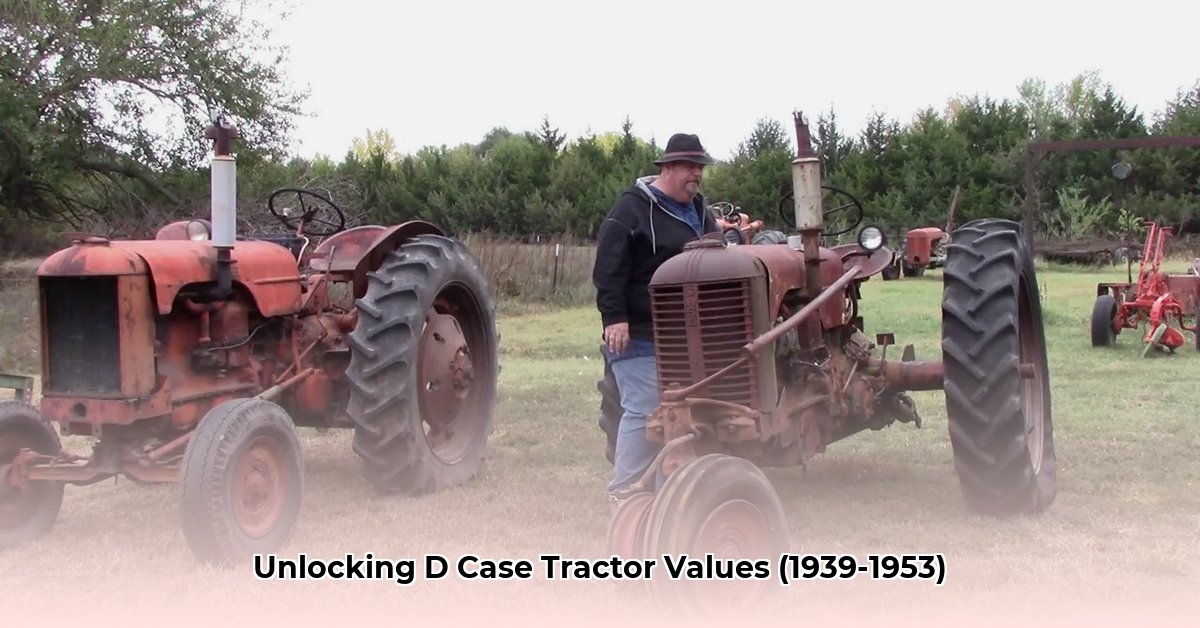
A Collector's Guide to the J.I. Case D Series
The satisfying rumble of a vintage J.I. Case D series tractor isn't just the sound of machinery; it's the echo of a bygone era of American agriculture. These robust machines, produced between 1939 and 1953, are more than historical artifacts; they're increasingly valuable collector's items. This guide navigates the complexities of the vintage Case D market, providing insights for seasoned collectors and newcomers alike. Whether you're appraising a potential purchase or restoring a family heirloom, understanding the factors that influence value is crucial. For more images of Case tractors, see Case tractor photos.
A Legacy Forged in Steel: The History of the Case D Series
The J.I. Case D series, a stalwart of American farming, isn't a single machine; it's a family of tractors. Production spanned from 1939 to 1953, witnessing significant advancements in agricultural technology and reflecting the evolving needs of farmers. Key variants, each impacting value, include the standard D, the DC (featuring a wider tread ideal for row crops), the DI (designed for industrial applications), and the DO (optimized for orchards). These differences, while seemingly subtle, are pivotal in determining a tractor’s current market value. Did you know, for instance, that the production numbers for the DI variant were significantly lower than the standard D? This makes the DI a highly sought-after model among collectors.
The Case D series wasn't just about horsepower; it was about innovation. The introduction of the Case Eagle Hitch, a three-point attachment system, significantly broadened functional capabilities and cemented its position as a true workhorse of its time. This feature, a key component in the tractor's desirability among collectors today, reflects the tractor's ingenious design and versatility.
Decoding the Mechanics: Technical Specifications and Key Features
The Case D series typically boasted approximately 38 horsepower (though actual power output varied depending on maintenance and condition). However, horsepower alone doesn't define the value; that's where the Eagle Hitch comes into play. This ingenious system substantially enhanced the tractor’s adaptability, making it suitable for a wider range of tasks and increasing its appeal to collectors. The presence of an original, well-preserved Eagle Hitch significantly boosts a tractor's value. Other key features to examine include the engine type, transmission style, and the overall condition of the chassis and body. A meticulously maintained engine and a well-preserved paint job tell a crucial story about the tractor’s history. Authenticity is key for a valuable Case D.
Market Analysis: Navigating the Price Landscape
The value of a Case D tractor is far from static; it's a dynamic interplay of numerous factors. Price ranges vary dramatically, from a few thousand dollars for a restoration project to tens of thousands for a meticulously restored model. Several key influencers shape this price fluctuation:
- Condition: A fully restored tractor in pristine condition will command the highest price. Rust, missing parts, and mechanical issues significantly reduce value. Rarity always plays a major factor.
- Variant: As mentioned earlier, the specific model (D, DC, DI, DO) significantly affects value, with rarer variants commanding higher prices.
- Location: Regional collector interest heavily influences prices. A rare model in an area with limited interest may sell for less than a common model in a high-demand region.
- Provenance: A documented history, particularly one linking the tractor to notable individuals or historical events, adds significant value. Complete ownership documentation is highly desired.
- Parts Availability: The scarcity and cost of replacement parts are key cost factors that factor into valuation.
While online auction data can provide a general guideline, it's crucial to remember that these prices are merely indicators. "Online data provides a starting point, but a true assessment necessitates hands-on inspection," advises John Miller, a renowned vintage tractor appraiser. An in-person inspection is absolutely vital to accurately gauge condition, functionality, and originality—all key determinants of value.
A Collector's Guide to the Case D Series: Actionable Advice
Aspiring Case D owners should follow these crucial steps:
- Thorough Research: Immerse yourself in the history of the Case D series, understanding the nuances of each variant and appreciating their unique features.
- Prioritize Originality: Original parts are invaluable. Restoration using authentic components significantly increases a tractor's worth and desirability.
- Meticulous Documentation: Keep detailed records of any restoration work, including parts sourcing and repair processes. This documented history greatly enhances the tractor's value and appeal.
- Network with Enthusiasts: Connect with other vintage tractor aficionados. Shared knowledge and communal expertise are invaluable resources.
- Professional Inspection: Before purchasing, seek a professional evaluation to accurately assess condition, mechanical soundness, and overall value.
The Future of the Case D in the Collector's Market
The Case D series is likely to maintain, and potentially increase in, value over time. Their historical significance, coupled with the increasing scarcity of well-preserved models, promises continued collector demand. However, market fluctuations will always occur. Diligent research and a thorough understanding of the market dynamics are key to successful collecting.
Appendix: Further Resources
(Note: Space limitations prevent inclusion of a detailed auction results table here. Further data may be found at [Link to supplementary auction data – replace with actual link]).